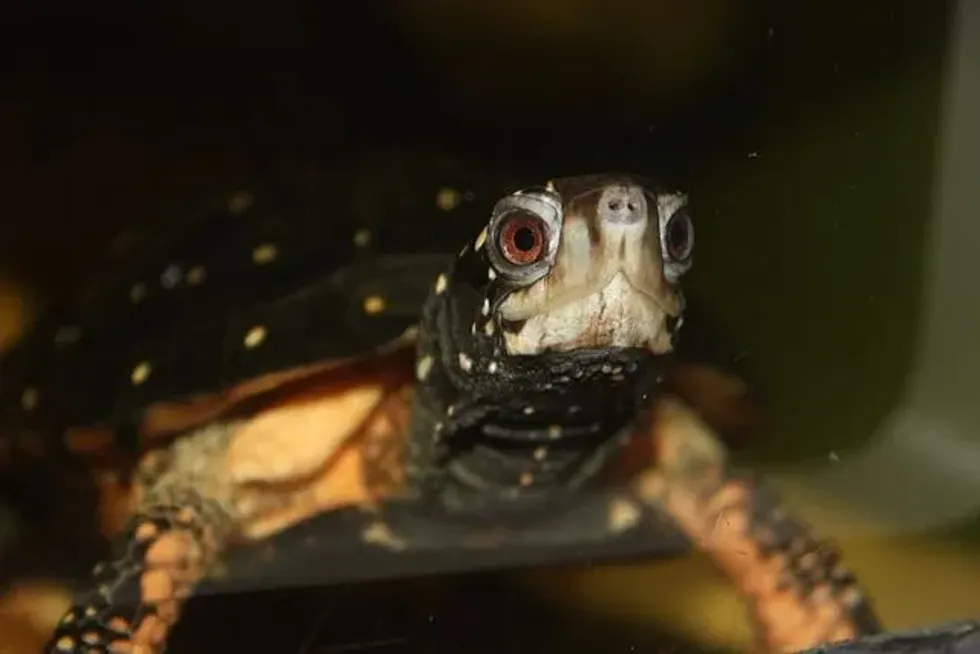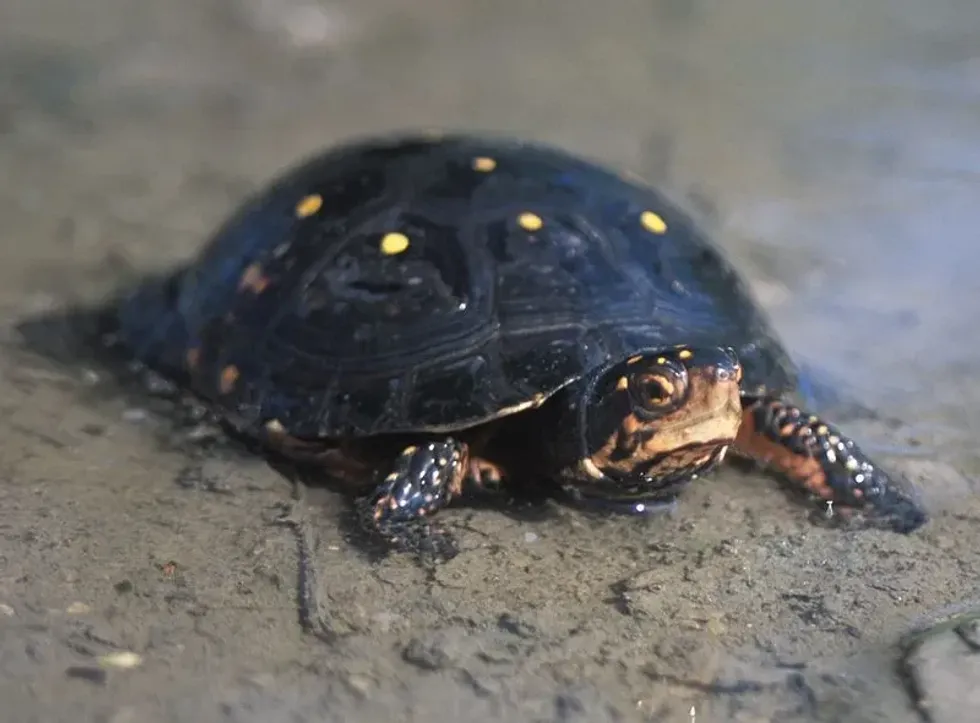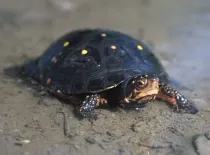Fun Spotted Turtle Facts For Kids
Love reading about amphibians and reptiles? Then these spotted turtle facts are just perfect.
The spotted turtle (Clemmys guttata) is one of the smallest semi-aquatic omnivorous turtles found around the Great Lakes in Canada and the Appalachian mountains in the US.
This particular species of turtles have become very popular recently in the pet trade as more and more people are adopting these beautiful adorable little reptiles due to their friendly nature and coloration.
Also, its, medium size largely adds to their charm. These turtles are born with a dark upper shell and beautiful yellow spots from their head to neck and limbs.
They are sexually dimorphic. They have a carapace length of 1.4-4.9 in (3.6-12.5 cm) which is an ideal size for being an indoor as well as an outdoor species of turtle.
The spotted turtle range is quite widely distributed but fragmented which has led the species to be declared endangered. Population declines have become evident due to several different reasons mentioned below along with other fun facts, so keep reading.
For more relatable content, check out these snapping turtle facts and Olive Ridley sea turtle facts for kids.
Spotted Turtle Interesting Facts
What type of animal is a spotted turtle?
A spotted turtle (Clemmys guttata) is a freshwater turtle of the Clemmys genus.
What class of animal does a spotted turtle belong to?
Spotted turtles (Clemmys guttata) belong to the class of Reptilia within the Animalia kingdom.
How many spotted turtles are there in the world?
The spotted turtle species has been classified as an Endangered species by the International Union for Conservation of Nature (IUCN) and their populations are alarmingly declining. Only local populations of the spotted turtles remain, and even that range is 30-1205 individuals.
Where does a spotted turtle live?
The species of spotted turtles are mainly found in central North America which includes the eastern United States, southern Canada, east of Appalachian mountains, and eastern Great Lakes. They are frequently spotted in places like southern Ontario, Quebec, central Illinois, north-central Florida, central Georgia, Maine, central Indiana, North Carolina, South Carolina, and the lower peninsula of Michigan.
Their highly fragmented distribution is one of the major reasons for its decrease in population.
What is a spotted turtle's habitat?
Spotted turtle habitat requirements are quite simple. The species prefers to live in small and shallow water bodies. Such wetland habitats include marshes, small ponds, fens, swamps, bogs, and coastal wetlands, or basically any small and still water bodies.
Who do spotted turtles live with?
Even though spotted turtles are generally known to be solitary, they are still capable of living together in the wild or in captivity. However, housing males together can be risky as they tend to get aggressive towards each other.
How long does a spotted turtle live?
The spotted turtle lifespan totally depends on its breeding conditions and meeting the habitat requirements. In the wild, the spotted turtles can live up to 25 years and in captivity, under proper care and environment, these turtles have been noted to live way over 50 years on average.
Female spotted turtles live longer. They live up to 110 years and males live around 65 years.
How do they reproduce?
Spotted turtles reach their sexual maturity between the age of 7-14 years. They are sexually dimorphic like black-breasted leaf turtle.
These reptiles have their mating activity season that begins in May and lasts through June. Once they are ready to mate, the males chase around a female turtle underwater while nipping and biting the female's legs and carapace to fend off other rival males.
The courtship occurs underwater and after the process is over, the nesting females look for moist soil to build a nest and bury the eggs, preferably in a sunny spot out in the open.
Females produce one or two clutches of elliptical eggs per year. The first clutch usually has one to eight eggs and she may lay a smaller second clutch a few days later.
The incubation period for these eggs is about 44-83 days and the gender of the hatchlings is decided by the nesting temperature or the surrounding water temperature. Cooler temperatures produce male turtles, and warmer temperatures produce females.
What is their conservation status?
The International Union for Conservation of Nature (IUCN) has classified the conservation status of the spotted turtles (Clemmys guttata) as an Endangered species with an alarmingly decreasing population due to habitat fragmentation ergo loss of habitat. Pollution, climate change, pet collection, low road mortality have also resulted in its Endangered status.
This species of turtles are quite sensitive to water quality, pollution, and water temperatures and will disappear quickly.
These turtles have recently become quite a popular pet choice in the US which results in further loss as they are collected from the wild and housed.
They are often victims of poaching or the pet trade due to the beautiful coloration on their upper shell or carapace and body. Their very specific habitat requirements and slow reproduction rate are also some of the reasons for their depleting numbers.
Spotted turtle predators are also a major reason why their population declines rapidly in the wild. Raccoons and muskrats love preying on these turtles and are prone to them mostly on land.
Spotted Turtle Fun Facts
What do spotted turtles look like?
The spotted turtle (Clemmys guttata) is currently the only species in the genus Clemmys and is one of the smallest turtles found in the US. This semi-aquatic turtle has an adult carapace length of 1.4-4.9 in (3.6-12.5 cm) where females are bigger than males.
Spotted turtles have a smooth dark gray to bluish-black upper carapace or shell with orange-yellow spots which extends not only on their upper shell but also from their head to neck out onto the limbs. The spotting pattern is unique to each turtle and the spots keep increasing as they grow older.
Spotted turtles display a wide range of sexual dimorphism.
The body is grayish-black all over. Their plastron differs in accordance with their gender.
Adult female turtles possess flat plastron and a shorter tail whereas the male turtles have a convex plastron and comparatively have a longer tail but the females are much bigger in size. Female adults have yellow or orange eyes and male adults have brown eyes.

How cute are they?
Spotted turtles can be considered quite cute due to their small size and beautiful color and spot pattern as they are covered with yellow spots all over their upper shell. They have become quite a popular choice for pets as they are quite friendly, hardy, and live longer in captivity.
They can live over 60 years easily. They are not that active throughout the year and display summer dormancy as they are active from March to October.
How do they communicate?
The idea of communication between turtles using sound is relatively new and not too well known, previously scientists believed that turtles were deaf and couldn't communicate as they have internal ears and vocal cords are absent.
With new research available, it has been discovered that amongst turtles, hatchlings can even communicate before they hatch, and in some species mothers communicate with the hatchlings.
Turtles have been observed to communicate during courtship through sounds, even express stress and fear.
These turtles can even communicate underwater with low-pitched calls to help them travel together and find their mates, through a method similar to radio telemetry. Radio telemetry is where electromagnetic waves are at work, and for the turtles, low-pitched calls are at work.
How big is a spotted turtle?
Spotted turtles are actually one of the smallest turtle species in the US. They have a carapace length of 1.4-4.9 in (3.6-12.5 cm) and have an average weight of 8-12 oz (226.8-340.2 g). The spotted turtle size depends on its gender. They are smaller than box turtles.
How fast can a spotted turtle move?
Spotted turtles can swim, prey, and breathe underwater as well as move, and run on land. However, their exact speed is not known due to a lack of enough information.
How much does a spotted turtle weigh?
Spotted turtles are sexually dimorphic, females are bigger and heavier than males. Male spotted turtles weigh about 8 oz (226.8 g) and females weigh about 12 oz (340.2 g) approximately. They are double the size of bog turtles.
What are the male and female names of the species?
Turtles in general, do not have any specific gender-based term or name for their males and females.
What would you call a baby spotted turtle?
A spotted turtle baby is called a hatchling. Hatchlings initially develop two yellow spots on either side.
What do they eat?
The spotted turtle diet actually has a wide range due to its omnivorous nature. They love feeding on soft aquatic plants, algae, and water lily seeds.
They also prey on several worms, small aquatic insects, amphibian eggs, mollusks, insect larvae, and carrion. They don't need to feed every day, they consume their entire meal in 15-20 mins and feed every other or third day.
The hatchling, on the other hand, must be fed in intervals throughout the day. Animal protein diets are preferred for females to help them breed better quality eggs.
Are they dangerous?
The spotted turtles (Clemmys guttata) are very harmless medium-sized semi-aquatic turtles. They are not aggressive and are easily startled. They love basking in the sun quietly but when threatened or startled, they will dive underwater and bury themselves in the mud. There have been very few cases of spotted turtles biting humans unless threatened or in pain.
Would they make a good pet?
Yes, spotted turtles actually make very good pets not only due to their unique pattern of yellow color spots on their upper shell and head till their neck but also due to their harmless nature. These species of turtles are very friendly and can live over 50 years in captivity with proper care.
Did you know...
Spotted turtles were once the most commonly sighted turtle in the vicinity of New York City during the early 1900s.
Do spotted turtles bite?
Yes, the species of spotted turtles do bite when threatened or in danger, otherwise, they aren't aggressive species at all and quite friendly. Even in the wild, this species is not very aggressive unless it's mating season.
Most of the time when they sense muskrat burrows, or other predators, they dive in the water and bury inside the mud. Male spotted turtles only fight each other during the breeding season for the attention of a female.
Keeping a spotted turtle pet
You can have a spotted turtle as a pet as they make great pets as spotted turtle care is easy. They have habitat requirements but they are easy to maintain and quite hardy as well as friendly to human touch.
They are equally adjustable indoors or outdoors but they do tend to thrive when kept in an outdoor enclosure according to its requirements, but only after they reach full maturity.
Female turtles will require a bigger tank. Females can be housed together with a male, but it is advised against while housing males together as they might get aggressive towards each other.
Among these species, the spotted turtle tank must be big and open for enough sunlight and space for them to roam around freely, must have a container for water, and should always be full and should be covered by grass mats. The water levels shouldn't cross their heads.
The diet is similar to that of a wild turtle, with fruits, and insect protein, but outdoor residents of this species in captivity should be given vitamin D3 supplemented calcium for better growth and for the purpose of gaining proper maturity.
Here at Kidadl, we have carefully created lots of interesting family-friendly animal facts for everyone to discover! Learn more about some other reptiles from our Hawksbill sea turtle facts and spiny softshell turtle facts pages.
You can even occupy yourself at home by coloring in one of our free printable spotted turtle coloring pages.
We Want Your Photos!
More for You
Bachelor of Arts specializing in Journalism and Mass Communication, Postgraduate Diploma in Sports Management

Moumita DuttaBachelor of Arts specializing in Journalism and Mass Communication, Postgraduate Diploma in Sports Management
A content writer and editor with a passion for sports, Moumita has honed her skills in producing compelling match reports and stories about sporting heroes. She holds a degree in Journalism and Mass Communication from the Indian Institute of Social Welfare and Business Management, Calcutta University, alongside a postgraduate diploma in Sports Management.
Disclaimer
1) Kidadl is independent and to make our service free to you the reader we are supported by advertising. We hope you love our recommendations for products and services! What we suggest is selected independently by the Kidadl team. If you purchase using the Buy Now button we may earn a small commission. This does not influence our choices. Prices are correct and items are available at the time the article was published but we cannot guarantee that on the time of reading. Please note that Kidadl is a participant in the Amazon Services LLC Associates Program, an affiliate advertising program designed to provide a means for sites to earn advertising fees by advertising and linking to Amazon. We also link to other websites, but are not responsible for their content.
2) At Kidadl, we strive to recommend the very best activities and events. We will always aim to give you accurate information at the date of publication - however, information does change, so it’s important you do your own research, double-check and make the decision that is right for your family. We recognise that not all activities and ideas are appropriate for all children and families or in all circumstances. Our recommended activities are based on age but these are a guide. We recommend that these ideas are used as inspiration, that ideas are undertaken with appropriate adult supervision, and that each adult uses their own discretion and knowledge of their children to consider the safety and suitability. Kidadl cannot accept liability for the execution of these ideas, and parental supervision is advised at all times, as safety is paramount. Anyone using the information provided by Kidadl does so at their own risk and we can not accept liability if things go wrong.
3) Because we are an educational resource, we have quotes and facts about a range of historical and modern figures. We do not endorse the actions of or rhetoric of all the people included in these collections, but we think they are important for growing minds to learn about under the guidance of parents or guardians.







